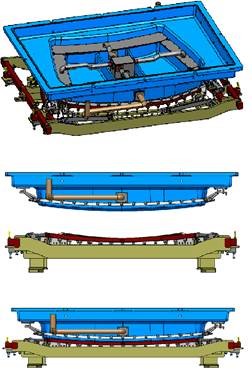Related Research Articles

An application-specific integrated circuit is an integrated circuit (IC) chip customized for a particular use, rather than intended for general-purpose use, such as a chip designed to run in a digital voice recorder or a high-efficiency video codec. Application-specific standard product chips are intermediate between ASICs and industry standard integrated circuits like the 7400 series or the 4000 series. ASIC chips are typically fabricated using metal–oxide–semiconductor (MOS) technology, as MOS integrated circuit chips.

Forging is a manufacturing process involving the shaping of metal using localized compressive forces. The blows are delivered with a hammer or a die. Forging is often classified according to the temperature at which it is performed: cold forging, warm forging, or hot forging. For the latter two, the metal is heated, usually in a forge. Forged parts can range in weight from less than a kilogram to hundreds of metric tons. Forging has been done by smiths for millennia; the traditional products were kitchenware, hardware, hand tools, edged weapons, cymbals, and jewellery. Since the Industrial Revolution, forged parts are widely used in mechanisms and machines wherever a component requires high strength; such forgings usually require further processing to achieve a finished part. Today, forging is a major worldwide industry.

Engineering tolerance is the permissible limit or limits of variation in:
- a physical dimension;
- a measured value or physical property of a material, manufactured object, system, or service;
- other measured values ;
- in engineering and safety, a physical distance or space (tolerance), as in a truck (lorry), train or boat under a bridge as well as a train in a tunnel ;
- in mechanical engineering, the space between a bolt and a nut or a hole, etc.

In industry, product lifecycle management (PLM) is the process of managing the entire lifecycle of a product from its inception through the engineering, design and manufacture, as well as the service and disposal of manufactured products. PLM integrates people, data, processes, and business systems and provides a product information backbone for companies and their extended enterprises.
Design for Six Sigma (DFSS) is an engineering design process, business process management method related to traditional Six Sigma. It is used in many industries, like finance, marketing, basic engineering, process industries, waste management, and electronics. It is based on the use of statistical tools like linear regression and enables empirical research similar to that performed in other fields, such as social science. While the tools and order used in Six Sigma require a process to be in place and functioning, DFSS has the objective of determining the needs of customers and the business, and driving those needs into the product solution so created. It is used for product or process design in contrast with process improvement. Measurement is the most important part of most Six Sigma or DFSS tools, but whereas in Six Sigma measurements are made from an existing process, DFSS focuses on gaining a deep insight into customer needs and using these to inform every design decision and trade-off.
ISO 10303 is an ISO standard for the computer-interpretable representation and exchange of product manufacturing information. It is an ASCII-based format. Its official title is: Automation systems and integration — Product data representation and exchange. It is known informally as "STEP", which stands for "Standard for the Exchange of Product model data". ISO 10303 can represent 3D objects in Computer-aided design (CAD) and related information.

Metal injection molding (MIM) is a metalworking process in which finely-powdered metal is mixed with binder material to create a "feedstock" that is then shaped and solidified using injection molding. The molding process allows high volume, complex parts to be shaped in a single step. After molding, the part undergoes conditioning operations to remove the binder (debinding) and densify the powders. Finished products are small components used in many industries and applications.

Design for manufacturability is the general engineering practice of designing products in such a way that they are easy to manufacture. The concept exists in almost all engineering disciplines, but the implementation differs widely depending on the manufacturing technology. DFM describes the process of designing or engineering a product in order to facilitate the manufacturing process in order to reduce its manufacturing costs. DFM will allow potential problems to be fixed in the design phase which is the least expensive place to address them. Other factors may affect the manufacturability such as the type of raw material, the form of the raw material, dimensional tolerances, and secondary processing such as finishing.

Precision engineering is a subdiscipline of electrical engineering, software engineering, electronics engineering, mechanical engineering, and optical engineering concerned with designing machines, fixtures, and other structures that have exceptionally low tolerances, are repeatable, and are stable over time. These approaches have applications in machine tools, MEMS, NEMS, optoelectronics design, and many other fields.

Precision glass moulding is a replicative process that allows the production of high precision optical components from glass without grinding and polishing. The process is also known as ultra-precision glass pressing. It is used to manufacture precision glass lenses for consumer products such as digital cameras, and high-end products like medical systems. The main advantage over mechanical lens production is that complex lens geometries such as aspheres can be produced cost-efficiently.
A First Article Inspection (FAI) is a design verification process for verifying that a new or modified production process produces conforming parts that meet the manufacturing specification detailed in technical or engineering drawings. Typically, a supplier performs the FAI and the purchaser reviews the report. The FAI process usually consists of fully testing and inspecting either the first part produced by the new process or a sample from the first batch of parts. First article inspection is typically a purchase order requirement of the purchaser for the supplier to complete. If the manufacturer doesn't have the in-house capability or if the purchaser requests, the first article inspection may be conducted by an approved subcontract supplier such as a dimensional inspection/metrology laboratory.

CNC plunge milling, also called z-axis milling, is a CNC milling process. In this process, the feed is provided linearly along the tool axis while doing CNC processing.
Virtual machining is the practice of using computers to simulate and model the use of machine tools for part manufacturing. Such activity replicates the behavior and errors of a real environment in virtual reality systems. This can provide useful ways to manufacture products without physical testing on the shop floor. As a result, time and cost of part production can be decreased.
Design for additive manufacturing is design for manufacturability as applied to additive manufacturing (AM). It is a general type of design methods or tools whereby functional performance and/or other key product life-cycle considerations such as manufacturability, reliability, and cost can be optimized subjected to the capabilities of additive manufacturing technologies.
Design for inspection (DFI) is an engineering principle that proposes that inspection methods and measurement instruments used to certify manufacturing conformity, should be considered early in the design of products. Production processes should be designed in such a way that features of the product are easy to inspect with readily available measurement instruments, and so that measurement uncertainty is considered in the tolerance that are applied. The concept can be applied in almost all engineering disciplines. DFI describes the process of designing or engineering a product in order to facilitate the measurement in order to reduce the overall costs of manufacturing and delivering products that satisfy customers.

Yoram Koren is an Israeli-American academic. He is the James J. Duderstadt Distinguished University Professor Emeritus of Manufacturing and the Paul G. Goebel Professor Emeritus of Engineering at the University of Michigan, Ann Arbor. Since 2014 he is a distinguished visiting professor at the Technion – Israel Institute of Technology.
Responsive computer-aided design is an approach to computer-aided design (CAD) that utilizes real-world sensors and data to modify a three-dimensional (3D) computer model. The concept is related to cyber-physical systems through blurring of the virtual and physical worlds, however, applies specifically to the initial digital design of an object prior to production.
Learning factories represent a realistic manufacturing environment for education, training, and research. In the last decades, numerous learning factories have been built in academia and industry.
Geometrical Product Specification and Verification (GPS&V). standards is a set of ISO standards developed by ISO Technical Committee 213. The aim of those standards is to develop a common language to specify macro geometry and micro-geometry of products or part of products so that it can be used consistently all over the world.
A digital project twin is a virtual equivalent of intangible assets and processes by using digits, particularly binary digits, around a temporary undertaking.
References
- ↑ Francis, Andrew; Maropoulos, Paul; Mullineux, Glen; Keogh, Patrick (2016). "Design for Verification The 9th International Conference on Digital Enterprise Technology – Intelligent Manufacturing in the Knowledge Economy Era". Procedia CIRP. 56: 61–66. doi: 10.1016/j.procir.2016.10.017 .
- ↑ Francis, Andrew; Maropoulos, Paul; Mullineux, Glen; Keogh, Patrick (2016). "Design for Verification (DfV)". Procedia CIRP. 56: 61–66. doi: 10.1016/j.procir.2016.10.017 .